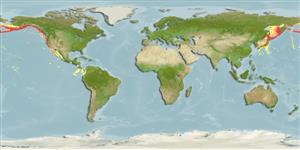>
Perciformes/Scorpaenoidei (Scorpionfishes) >
Sebastidae (Rockfishes, rockcods and thornyheads) > Sebastolobinae
Etymology: Sebastolobus: Greek, sebastes = august, venerable + Greek, lobos = lobe (Ref. 45335); alascanus: Species name after Alaska, the type locality (Ref. 27436).
More on author: Bean.
Environment: milieu / climate zone / пределы глубины / distribution range
экология
морской демерсальный; пределы глубины 17 - 1600 m (Ref. 50550), usually 91 - ? m (Ref. 2850). Temperate
North Pacific: Sea of Okhotsk north to the Navarin Canyon in the Bering Sea and from Stalemate Bank and Ulm Plateau in the Aleutian Islands southeast to Cedros Island, Baja California, Mexico. Reported from Japan (Ref. 559).
Length at first maturity / Size / Вес / Возраст
половая зрелость: Lm 22.0 range ? - ? cm
Max length : 80.0 cm SL самец/пол неопределен; (Ref. 559); наибольший вес (опубликованные данные): 9.0 kg (Ref. 56527); наибольший возраст (опубликованны данные): 100 годы (Ref. 90032)
Краткое описание
определительные ключи | морфология | морфометрия
колючие лучи спинного плавника (общее число) : 15 - 17; членистые (мягкие) лучи спинного плавника (общее число) : 8 - 9; колючие лучи анального плавника: 3; членистые (мягкие) лучи анального плавника: 4 - 5. Head spines very strong - nasal, preocular, supraocular, postocular, tympanic, parietal and nuchal spines present, coronal spines absent; large head and elongate body; strong spiny ridge on head; 3rd dorsal spine not much longer than 2nd, 4th or 5th; strong notch on pectoral fin (Ref. 27437). Bright red with some black on fins; gill chamber mostly pale (Ref. 27437). Caudal slightly rounded (Ref. 6885).
Body shape (shape guide): fusiform / normal.
Very common on soft bottoms (Ref. 2850). Oviparous (Ref. 205). Eggs are extruded in floating gelatinous masses (Ref. 31279). Have a thick glandular tissue on posterior margin of fin spines which is believed to be venomous (Ref. 57406). Rarely taken by game fishers (Ref. 27436). Flesh sweeter than that of other rockfishes (Ref. 27436).
Unlike other representatives of this group, this species has internal fertilization Oviparous (Ref. 6885). Females possess specialized ovarian structures including stalk-like ovigerous lamellae and secretory epithelia (Ref. 32832).
Eschmeyer, W.N., E.S. Herald and H. Hammann, 1983. A field guide to Pacific coast fishes of North America. Boston (MA, USA): Houghton Mifflin Company. xii+336 p. (Ref. 2850)
Статус Красного Списка МСОП (Ref. 130435: Version 2025-1)
Использование человеком
рыболовство: не имеет хозяйственного значения
дополнительная информация
инструменты
Специальные отчеты
Скачать в формате XML
ресурсы в Интернет
Estimates based on models
Preferred temperature (ссылка
123201): 1.2 - 6.7, mean 3.8 °C (based on 417 cells).
Phylogenetic diversity index (ссылка
82804): PD
50 = 0.6250 [Uniqueness, from 0.5 = low to 2.0 = high].
Bayesian length-weight: a=0.00692 (0.00397 - 0.01205), b=3.16 (3.00 - 3.32), in cm total length, based on LWR estimates for this species & (Sub)family-body (Ref.
93245).
Trophic level (ссылка
69278): 3.6 ±0.3 se; based on diet studies.
Generation time: 47.8 ( na - na) years. Estimated as median ln(3)/K based on 1
growth studies.
устойчивость к внешним воздействиям (ссылка
120179): очень низкий, минимальное время удвоения популяции более 14 лет (tmax> 100 (validated age: 62 yrs); tm= 13; Fec > 10,000).
Prior r = 0.03, 95% CL = 0.02 - 0.05, Based on 2 full stock assessments.
Fishing Vulnerability (Ref.
59153): High vulnerability (59 of 100).
🛈
Climate Vulnerability (Ref.
125649): Moderate vulnerability (38 of 100).
🛈
Nutrients (Ref.
124155): Calcium = 18.4 [8.0, 49.9] mg/100g; Iron = 0.287 [0.128, 0.565] mg/100g; Protein = 17.5 [15.8, 19.3] %; Omega3 = 1.01 [0.41, 2.73] g/100g; Selenium = 29.6 [13.0, 73.1] μg/100g; VitaminA = 13.5 [3.9, 44.9] μg/100g; Zinc = 0.518 [0.305, 0.810] mg/100g (wet weight);
